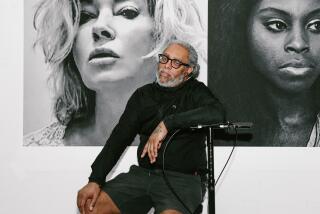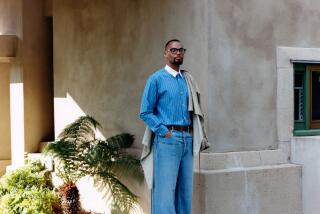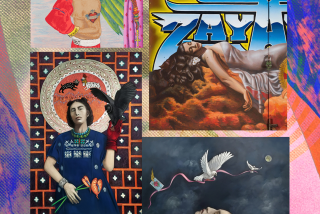Kendrick Lamar’s video director Kahlil Joseph takes his hypnotic art to MOCA
The video is like a feverish dream of Los Angeles. Beneath the sprawling, horizontal cityscape, a marching band grooves on an empty field. Young boys drip-dry after a dip in the pool. A woman with a tower of gray hair and a kindly gaze stands before a cooler of beer. Muscular, tattooed men pose for a group portrait. A horse gallops down a dim city avenue. And a man hangs upside-down, vampire-like, from a street light at night.
The 15-minute piece, titled “m.A.A.d.,” is now on view at Los Angeles’s Museum of Contemporary Art. And it is hypnotic: a stirring, cinematic tribute to the city of Compton, and a beguiling non-linear paean to everyday moments of life, death and magic — all set to the textured, often abstract lyrics of Compton-born rapper Kendrick Lamar. (Sample line: “I’m hoping that I can borrow a piece of mind / I’m behind on what’s really important.”)
The man behind this stunning short film is Kahlil Joseph, a young Los Angeles-based artist and director who keeps a determinedly low personal profile, preferring that his work does the talking for him. In music circles, he is best known for producing pieces that violate just about every rule of the music video: There are no choreographed dance sequences, no jiggling backup dancers, no literal interpretation of the lyrics. Instead, there is simply a mood — and worlds where strange things happen.
In a 2010 video for the experimental hip-hop group Shabazz Palaces, Joseph had an upside-down camera follow a running figure through the streets of Watts. In “Black Up,” another video for Shabazz Palaces, black figures dressed in white lie strewn over a ruined urban landscape. And in the enthralling “Until the Quiet Comes,” created for electronic musician Flying Lotus in 2012, a man dies and comes back to dancing life, an angel of death in a film that treats the screen as if it were a massive color field painting.
But “m.A.A.d.” takes this finely honed work to another, more powerful level at MOCA. For one, there’s the scope of the work: a story of people and place whittled down from more than seven hours of footage that Joseph shot around Compton in 2013, along with hours of vintage home movies supplied by Lamar. And then there’s the installation: a pair of side-by-side screens, each 16 feet wide and placed in the shape of ‘V,’ a form that holds the viewer in a cinematic embrace.
The low-key Joseph says that when he screened the completed film last fall at the Underground Museum, a nonprofit arts space in L.A.’s Crenshaw District that he runs with his brother, painter Noah Davis, it got a good reception. “It had a power and a beauty,” he recalls. “It resonated with people walking in off the streets.”
The video, interestingly, began life as concert footage for Lamar. When the rapper was tapped to open for Kanye West’s “Yeezus” tour in 2013, he called on Joseph to art-direct his live performances. Joseph says that despite the grueling deadline — he had only a few weeks to shoot and assemble the footage — and the fact that he’d never worked on a live concert, he nonetheless jumped. “It was rare to have that much budget to shoot in a black community,” he says.
The tight schedule, however, didn’t leave much time for finessing.
“I didn’t have time to articulate my full vision,” he says. The first time he saw the show live, he remembers, “I had my head in my hands for the first half hour.”
But Joseph polished the work as the tour progressed — and for six months after the tour was over. Last summer it screened as a single-screen film as part of the Sundance Next Fest at the Ace Hotel in downtown Los Angeles. And in the fall he debuted it as a two-screen work at the Underground Museum. That was when MOCA came calling.
“The piece just felt really fresh to me,” says MOCA chief curator Helen Molesworth. “I know that’s a dumb curatorial word. But he has a way of giving us pictures of Los Angeles that are on the one hand really familiar, but are also updated and pulled into the present. I came back and looked at the exhibition schedule and said, ‘Let’s go for it. Let’s not wait.’”
For Joseph, the film is an opportunity to render African American life in a creative, nuanced way.
“Everyone wants to see themselves on the screen,” he says. “But when I see black people in movies, I don’t see them as I know them to move and talk. That’s why Kendrick’s home movies are so profound. It’s like a painting in every frame, with the music bleeding in and out.”
Joseph is handsome and soft-spoken, with a goatee flecked by gray — an artist who at the age of 33 is confident of his artistic aims, yet remains demure about his achievements. He’s as comfortable in the world of music videos as he is in the world of contemporary art.
He does much of his work out of an office at the rear of the Underground Museum, where we chat in a sunny garden, studded with sculpture. “People from the neighborhood, they find their way back here,” he says gesturing toward a fire-pit, “and you can just see their minds go, ‘Ahhh.’”
Born and raised in Seattle, Joseph is the eldest son of a teacher mother and a lawyer father. He landed in Los Angeles in 1999 and studied a mix of art, art history, photography and television at Loyola Marymount University. But his interest in film dates back to high school.
Feeling homesick during an exchange program in Brazil, he decided to watch the Academy Awards. “That was the year ‘Good Will Hunting’ won,” he says. “And I thought, if two kids from Boston can write, I can write. So I started writing right then and there.”
In L.A., he immersed himself in cinema. In school, he studied the works of 20th century Russian filmmaker Andrei Tarkovsky, a director renowned for doing away with conventional narratives. And at night, he devoted himself to working his way through the available catalog of Asian films.
“I was an early adopter of Netflix,” he recalls. “I was living in a $500 a month apartment in Inglewood and I’d get a different Asian movie every two days ... It blew my mind how unconcerned they were with the three-act structure.”
To cover his expenses, he worked as a production assistant on music videos.
“I had to clean up video girl throw-up out of some rapper’s trailer,” he chuckles. “That was it for me.”
More transformative job opportunities followed. He worked as an intern in visual artist Doug Aitken’s studio, a figure who uses film in highly photographic ways. From there, he went to the Director’s Bureau, the Los Angeles production company co-founded by Roman Coppola. He got the job, he says, because, “I bugged the [heck] out of them.”
Doing office work, writing treatments, and simply being able to observe the work of established directors, he blossomed.
“They know it is a business,” he says of the Director’s Bureau, “but they respect people’s voices. It was the kind of place where writers and musicians would come by. Werner Herzog would stop by.”
Joseph spent five years there before moving on to an editing job with director Terrence Malick in Texas. “That was the best thing that ever happened to me,” he says. “There was being born and there was this.”
It was with Malick, he says, that he honed his editing skills — which is where he believes the power in filmmaking truly resides.
“The editing, that’s how you tell the story,” he says. “That’s how you paint the subject. In Stanley Kubrick films, the master craft is the edit.”
Soon Joseph began to make music videos. But his videos were more like experimental short films — like the 2010 video “Belhaven Meridian,” which is done in one sumptuous, continuous black-and-white take.
“I try to soak it all in: the lyrics, the artist, where they are from,” he says. “I’m trying to get at the core of what they are trying to express musically.”
Early last year, his work came to the attention of the art world when artist Kara Walker featured two of his videos — “Until the Quiet Comes” and “Black Up” — in an exhibition she curated at the Institute of Contemporary Art at the University of Pennsylvania called “Ruffneck Constructivists.”
“It’s rare to meet someone who exceeds your expectations,” Joseph says of Walker.
His artful methodology is something he once again applied to the pieces he produced for Lamar.
“Kendrick’s music has soul and it has poetry and it vibrates inside me,” explains Joseph. “His observation of the black experience, his own experience, is so shockingly profound ... You can’t just do a music video. That would cheapen it.”
The story “m.A.A.d.” tells of Compton is nuanced and deep, of working women, tittering nerd girls, ebullient young men and aggressive thugs — some real, some of which are Joseph’s invention. He even makes the city’s architecture one of his characters: the Modernist crown of the Martin Luther King memorial, the Japanese lines of a Craftsman home, the textile blocks of a drive-through funeral home.
Through this rich, real-but-not-quite-real panorama, the viewer floats in and out and back in again.
“What’s cool about the visual, about movies, is that they are like dreams,” says Joseph, “And dreams are some of the most personal things.”
“Kahlil Joseph: Double Conscience,” is on view through August 16 at the Museum of Contemporary Art’s Grand Avenue space. 250 S. Grand Ave., downtown Los Angeles, moca.org.
Find me on Twitter @cmonstah.
More to Read
The biggest entertainment stories
Get our big stories about Hollywood, film, television, music, arts, culture and more right in your inbox as soon as they publish.
You may occasionally receive promotional content from the Los Angeles Times.











